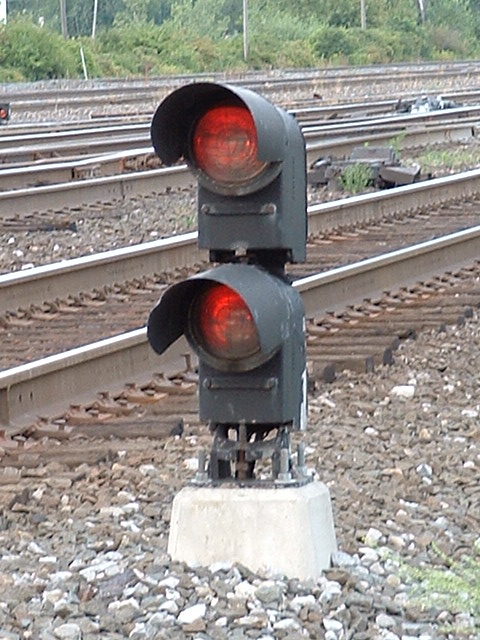
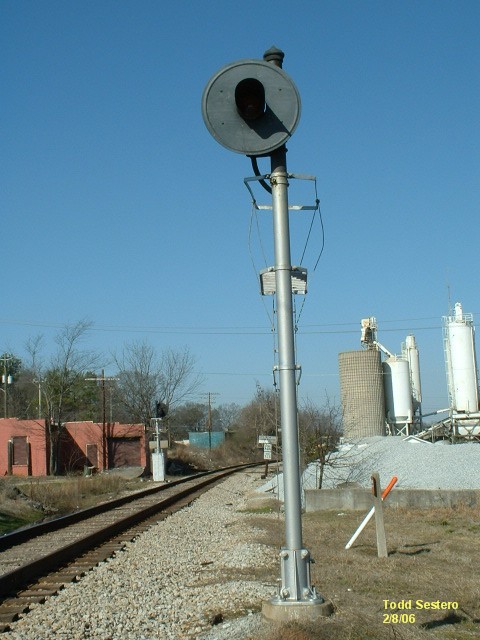
RAILROAD SIGNALS of the U.S.


SEARCHLIGHT SIGNALS
► History
► Searchlight Basics
► GRS/Alstom Searchlights
► US&S Searchlights
►
Location Pictures
RAILFAN GUIDES HOME
RAILROAD SIGNALS HOME
Searchlight signals are actually pretty neat despite their simple appearance. In one "small" signal housing, you have the ability to produce (up to) three aspects. Searchlight signals don't usually grab a whole lot of attention because they don't have the "pizzaz" that semaphores, color position light (CPL's) or position light (PL's) signals have. But make sure you get your pictures of them however, for they are quickly disappearing, just like CPL's and PL's.
The searchlight signal was "invented" by Thomas Hall in 1869, and was produced by the Hall Signal Company until 1925 when Hall was acquired by US&S. US&S searchlight models were the H series: the H; the H-2; H-2 variants the H-3 and H-4; and finally the H-5.... and the "H" is in honor of Hall. As of a few years ago, US&S/Ansaldo still had them in their catalog.
From Wikipedia: George Westinghouse founded Union Switch & Signal in 1881, consolidating the assets of the Union Electric Signal Company (founded by track circuit inventor William Robinson) and the Interlocking Switch & Signal Company (which had pioneered interlockings). In 1925 US&S acquired the Hall Signal Company, primarily to obtain the latter company's patents for searchlight signals. (Wikipedia disclaimer: Wikipedia is NOT known for total accuracy, despite the best efforts of their Gestapo type antics from their senior editors).
GRS started selling its "SA" series of searchlight signals in 1927 and produced them into the 1980's. Apparently, they became more popular than the US&S signals.
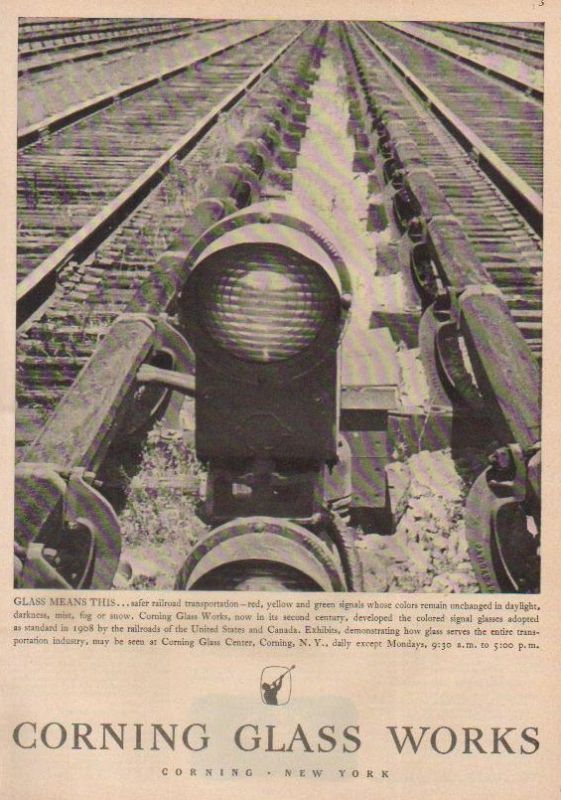
Searchlight signals have only one set of lenses and a single light source. Compare this to a stack of color light signals which can have 9 or 10 lamps/lenses in three housings, or, to a fully loaded CPL set with 14 lamp assemblies (each with it's own lock, BTW), or, to a fully loaded PL signal which has 16 lamp assemblies (not to mention all of the piping, brackets, and wiring that goes along with all of that).
The searchlight signal is one of the few signals that uses a reflector. The reflector is elliptical in shape, and the bulb is put at the focus point of the reflector. The placement of the bulb is positioned so that the light beam is focused to another focal point before leaving the lamp assembly.
Before leaving the lamp assembly, the light beam passes through one of the three roundels, or filters. They are mounted to a miniature "spectacle", similar to what is used on a semaphore signal. The spectacle is normally at rest with the middle roundel in the light beam, held in place by gravity and a counterweight placed on the spectacle. At rest, they display their most restrictive aspect, which is usually red.
To change colors, a motor, or relay like mechanism rotates the spectacle when energized to place one of the other two roundels into the light beam. Which way the spectacle rotates depends on the polarity of the energizing current. Remove the current, and the spectacle falls back to its middle position, making the signal inherently fail-safe.
In many of the models, as the light beam exits the lamp housing, it passes through a second lens. This pair of lenses is referred to as the inner and outer doublet lenses. In some GRS units, they use a "stepped", or Fresnel lens, and it is the only one in the entire signal, no inner or outer doublets.
With the reflector, and all of the focusing done by the two sets of lenses, the searchlight signal exhibits a generally pretty narrow beam. And also because of this, many searchlight signals use a 10 watt light bulb, in comparison to a 25 watt bulb found in most color light signal lamps, some use as little as 3 or 5 watts. A searchlight signal could typically have a one mile viewing range under optimal conditions. The low power requirements made them popular in the "old days" when trackside power was not available in rural locations and signals ran off battery power.
Because searchlight signals are so focused, they can be difficult if not impossible for the engineer to see when alongside the signal, so US&S and GRS came up with ways to deflect a small portion of the light towards a spot where the cab should be when stopped for the signal. This is done by either placing an integral lens on the outer surface of the outer lens, or by placing a small deflecting lens in between the outer doublet lenses.
For all of the advantages a searchlight signal offers the railroads, they are not without their drawbacks. They require periodic removal and maintenance because of their mechanical nature... not as complicated as a semaphore mechanism, but nevertheless, it is still complex and subject to failure. This is the main reason they are being replaced with colorlight signals.
To compete with searchlight signals,
Safetran came up with their Unilens signals. The Unilens signal employs 3
or 4 bulbs, sending their light out of a single lens via a colored filter and a
fiber optic cable. Engineers report that the signals are not as
readable in the bright sunlight as other signals. I have seen Unilens signals
in two places: one is on the Canadian Pacific south of
Binghamton NY, the other is in
Baltimore where they had the "wall fall" in 2015, and had to replace a dwarf
searchlight installation that was destroyed when the wall came crumbling down.
Below are typical cross sections.
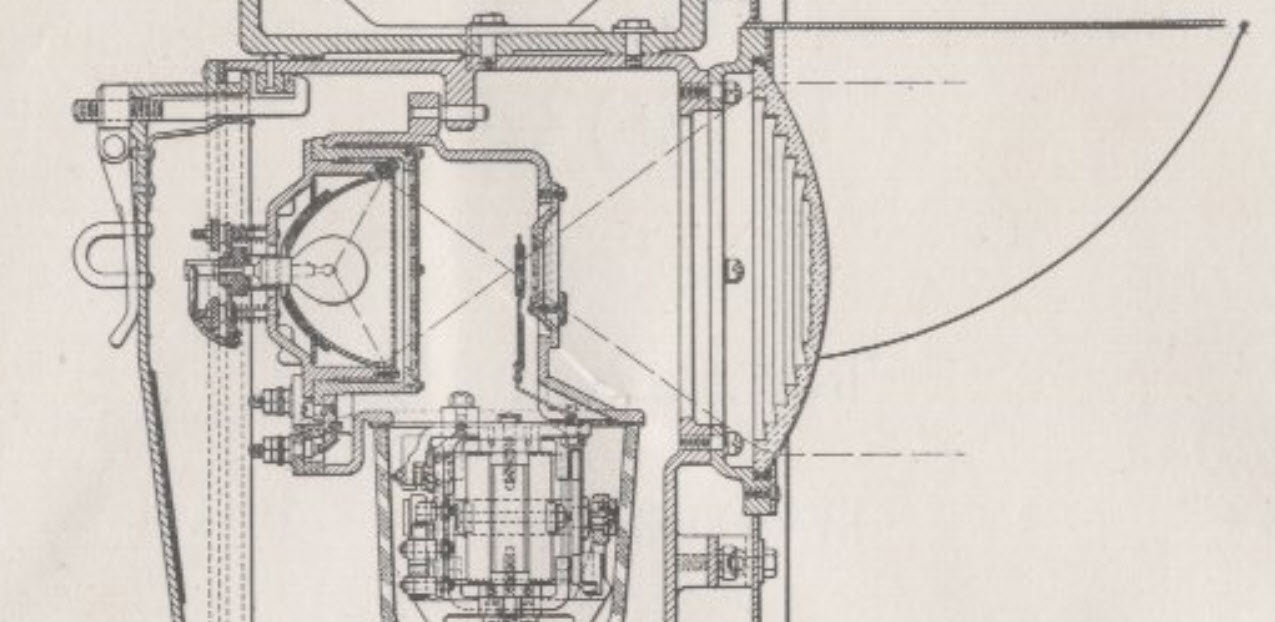
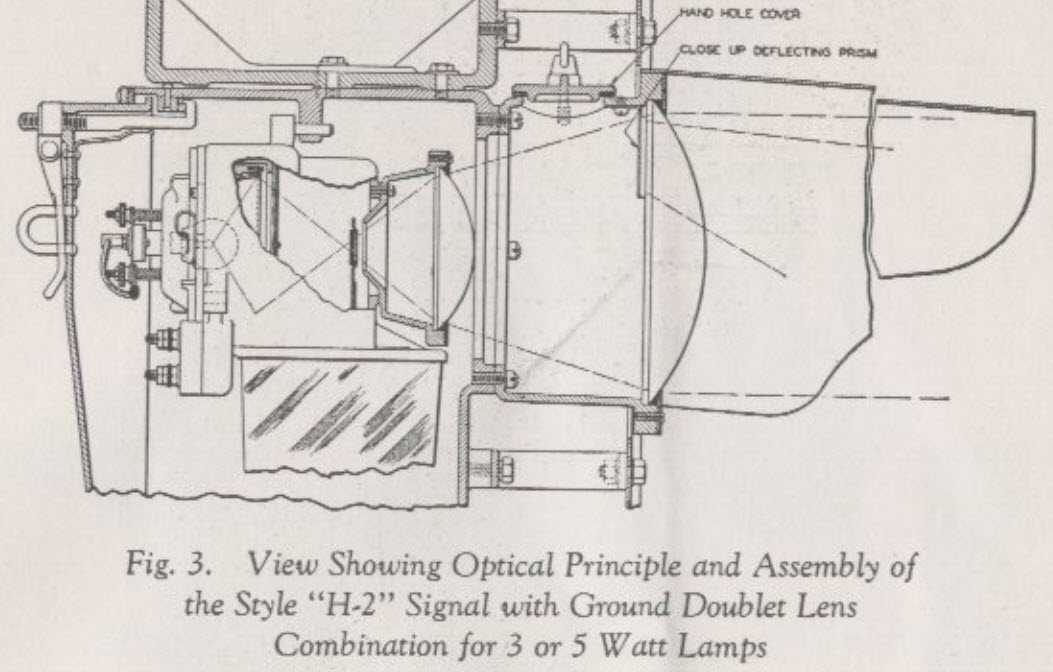
For more info on US&S searchlights,
check out:
http://www.trainweb.org/signals/usssls1.htm
And for more info on GRS signals, check out
http://www.trainweb.org/signals/grssls1.htm
GRS / Alstom Searchlight Offerings
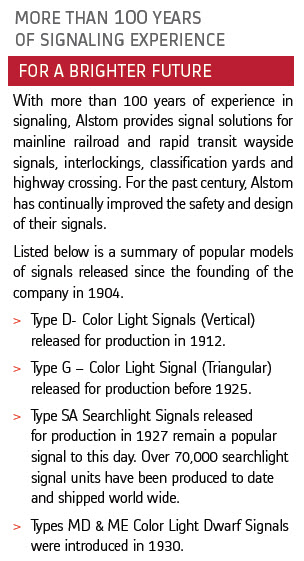
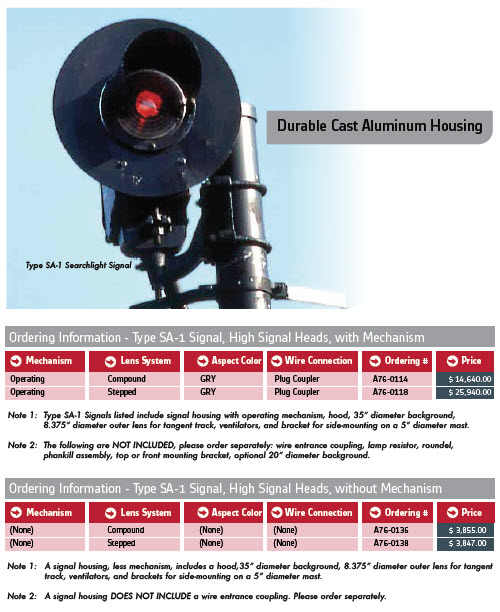
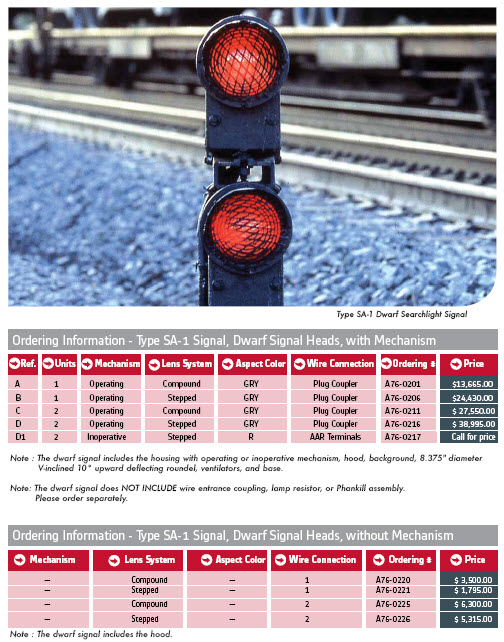
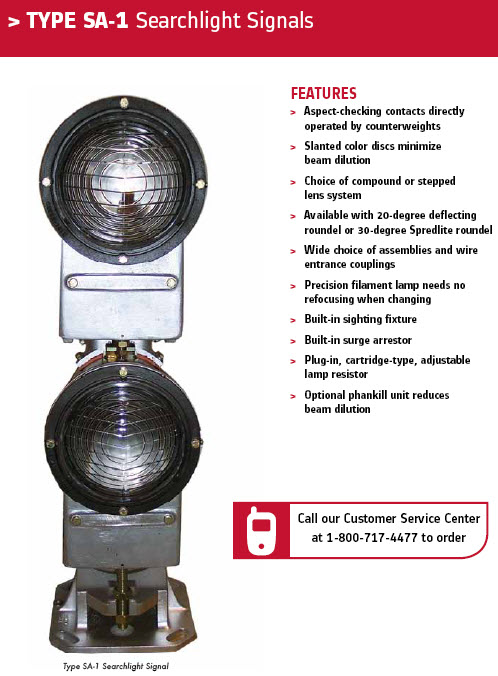
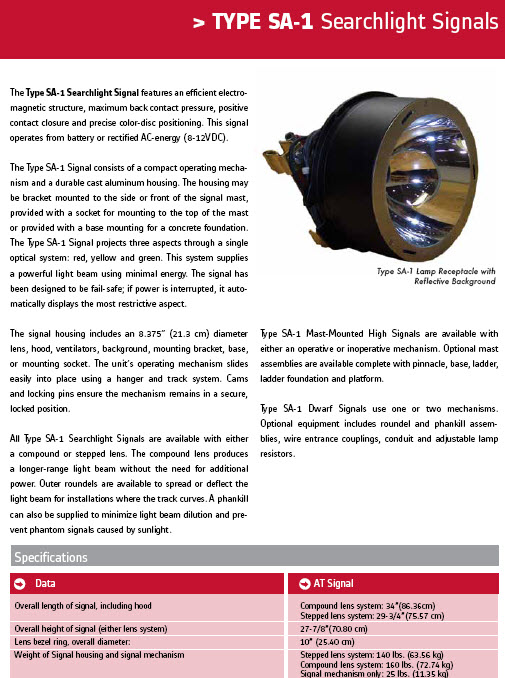
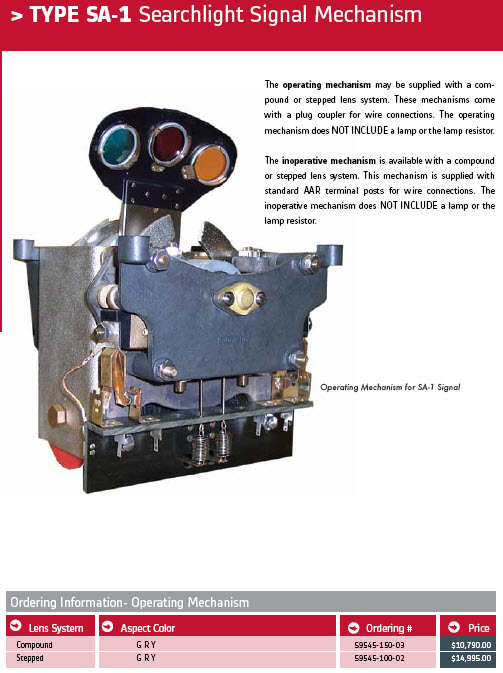
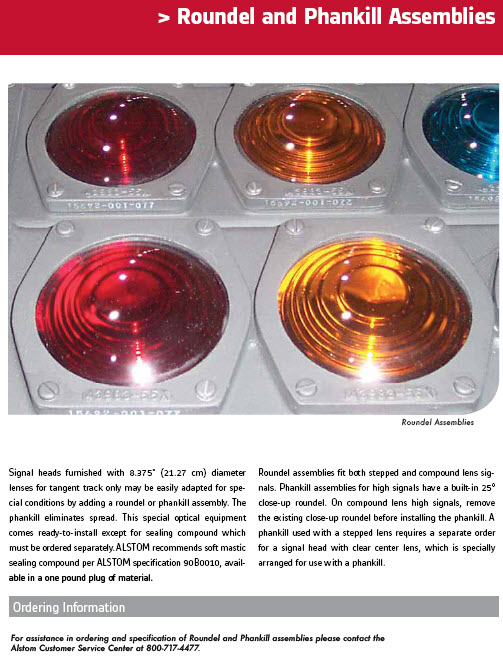
For an excellent discussion on US&S's searchlight signals, check out this page. Why re-invent the wheel?, it's a lot easier to stick a link in here :-)
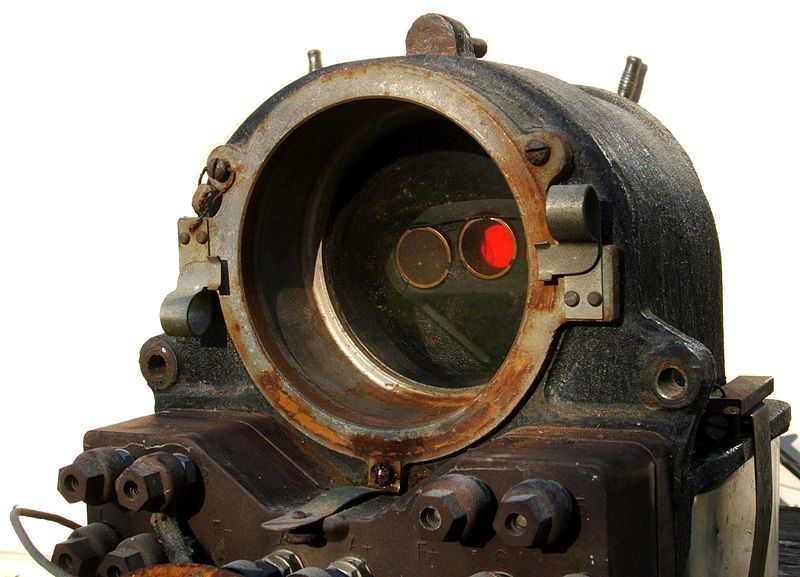
A US&S H-2 mechanism. Un-energized, the red roundel sits
in the light path. Photo by Douglas W. Jones, found on Wikipedia
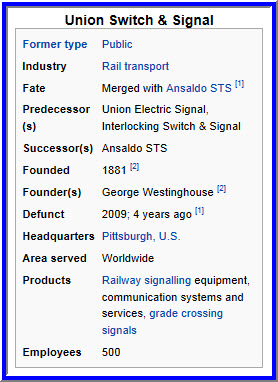
Corfu
NY
Buffalo NY 1
Buffalo NY 2
Buffalo NY 3
Atlanta GA
Houston TX - Pierce Junction
Mason City IA
Houston TX - Tower 87
Toronto ON -
Union Station Area
Corfu NY
- Ex NYC Mainline Buffalo to NYC (it's now CSX)
This easy to access signal bridge is located about halfway between Buffalo and
Batavia NY at Colby Rd (a little east of Corfu), about a 100 yards south of Hwy 33. When I lived in Batavia
back in 64-65, this was a nice 4 track mainline!
For a guide to the line between Batavia and Depew, click here
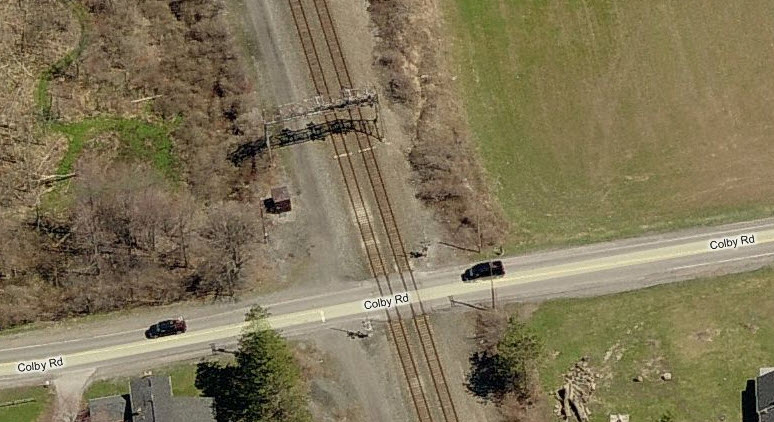
Buffalo NY 1 - Ex NYC Mainline to NYC
Signal bridge adjacent to Niagara Frontier
Hobby Shop in Buffalo
More pictures of the area are the Depew railfan guide.
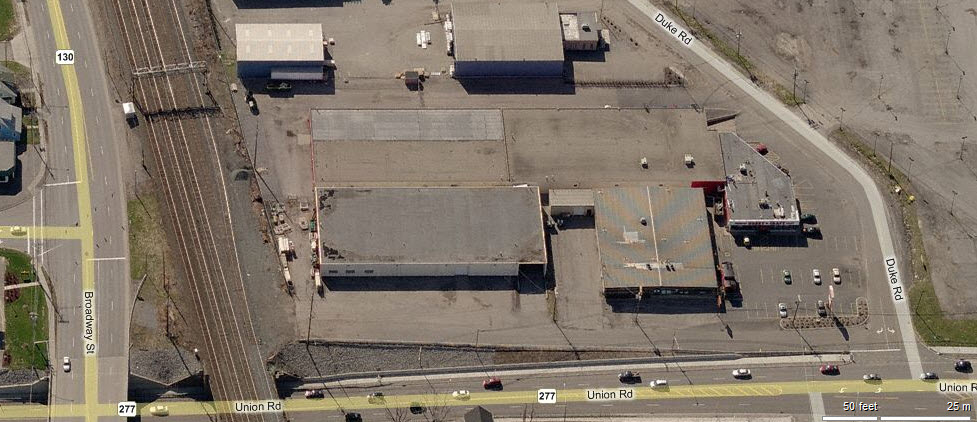
The signal bridge is in the upper left corner, and the big
building next to the tracks is Caboose Hobbies.
Buffalo NY 2 - Ex NYC Mainline to NYC
A couple of GRS dwarf Searchlights a few hundred feet from the above signal
bridge
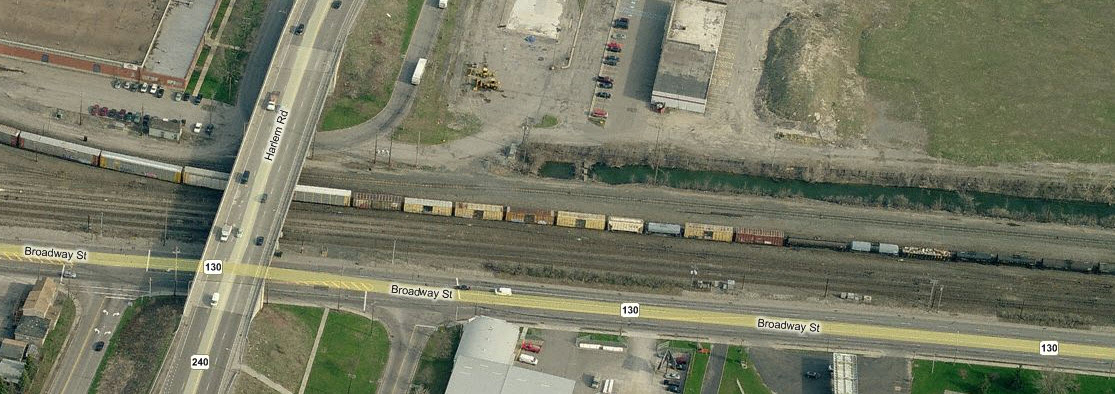
It's tough to see the dwarf signals in this picture, but
they're there!
Buffalo NY 3 - Ex NYC Mainline to NYC
Cantilever signal bridge near the two above sets (yea, I know, crappy day for pictures!)
These signals also appear on this railfan guide for buffalo.
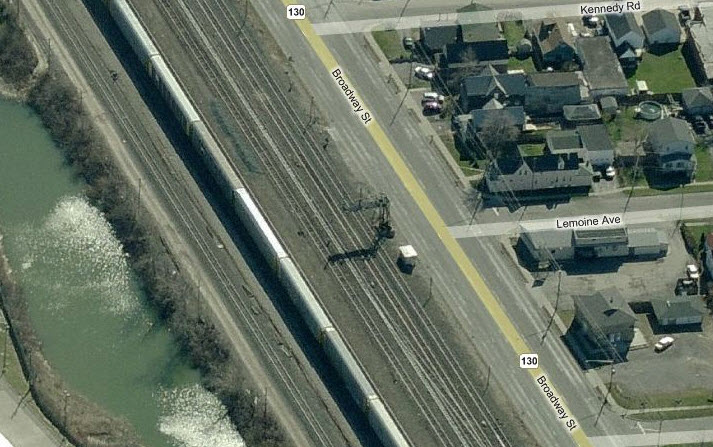
Atlanta GA
1 - Ex Georgia RR Line to Augusta GA (now CSX)
These two signals can
be found in Atlanta's east side suburb of Scottdale along Ponce de Leon Ave at Claredon Ave.
(inside the perimeter (i285) at exit 40).
This used to be the Georgia RR mainline to Augusta GA. There are quite a
few good photo spots along this road, as the tracks run next to it with ample opportunities to pull off the road and park.
Church St runs on the other side of the tracks, although the photo ops are not as good on the that side.
Train frequency seems to be about one train an hour, at least during the
afternoon on a Thursday.
Lots of UP power was seen on this CSX line going to Augusta when the pix were
taken in 2006. Not sure if the signal is a model "H" or H-2"
Above: Pictures of the cabinet mounted signal - for eastbound trains.
Above: Pictures of the westbound signal.
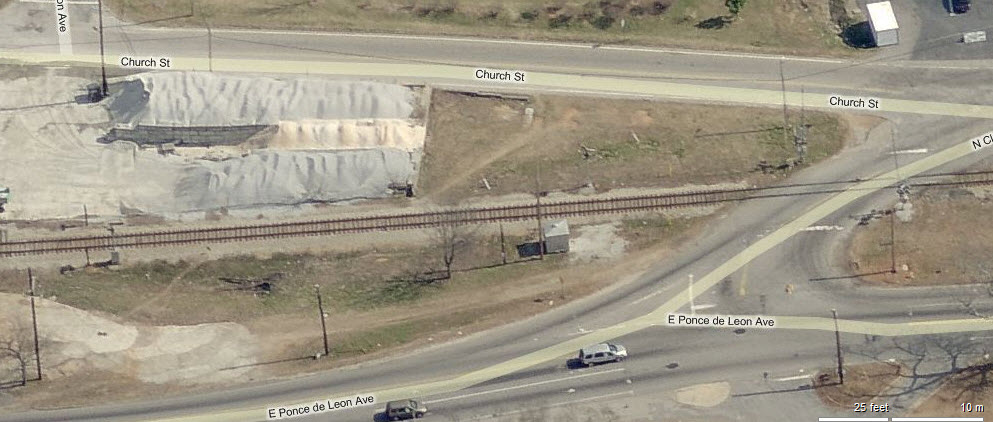
Houston TX 1 - Pierce Junction - ex SP now UP
A pair of H-2 searchlight signals on the
eastbound approach side of the diamond at Pierce Junction in southwest Houston.
Note that the the high signal has a sight bracket and background, where the low
signal does not - the low signal controls the siding. Note both signals
are mounted on the top of the mast.
For a complete review of the diamond, click here.
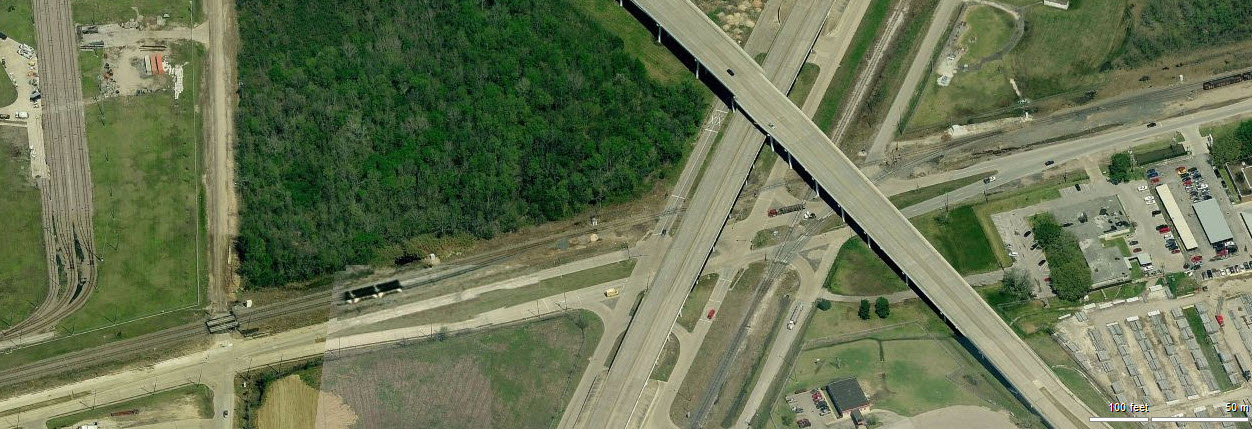
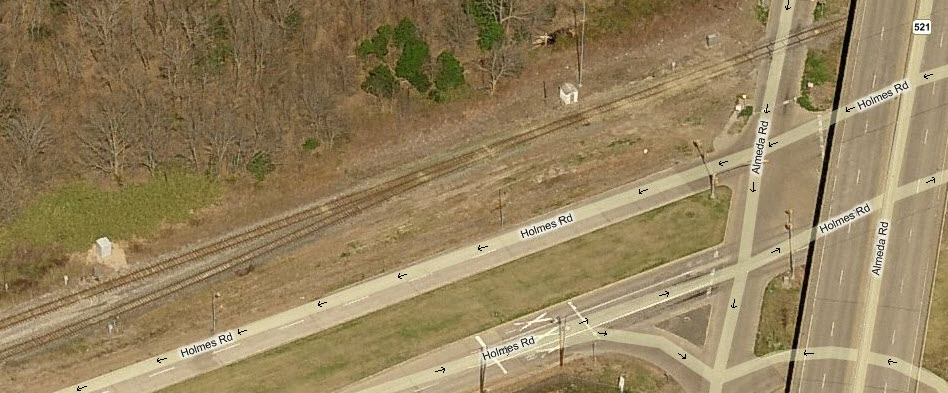
Mason City IA 1 - UP
This US&S H-2 Searchlight controls
northbound NB UP traffic at a crossing with
with the Iowa Traction. The the signal is mounted to the side of the pole,
and sits atop the relay cabinet. More pictures of this diamond can be
found here.
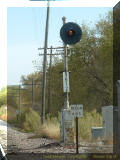


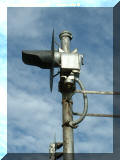
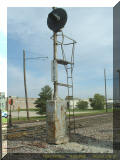
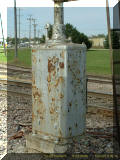
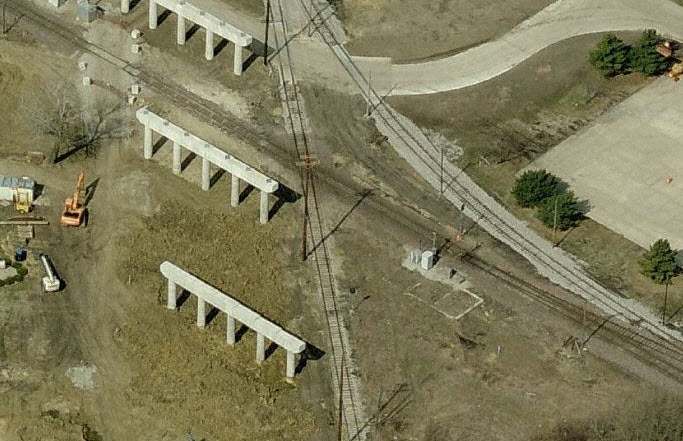
North is to the right, I'm guessing the overpass should be
done by now (11/2010)
Houston TX
2 - Settegast
Yard/Kirkpatrick Junction - ex SP, now UP
A lone SA-2 searchlight amidst all of the
color signals in the area. Note the different hood compared to the US&S
style.
For more pix of the signals around Tower 87,
click here.
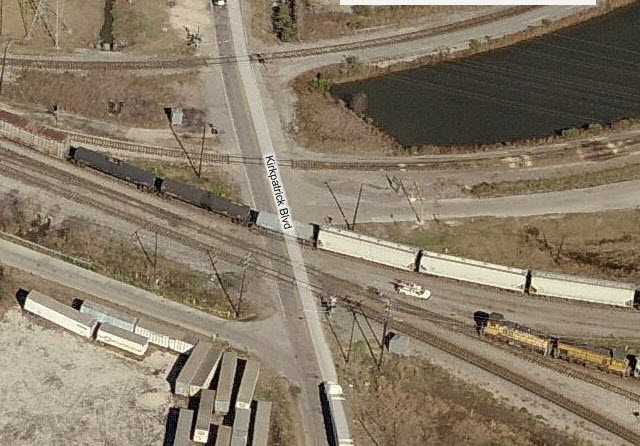
This signal is just above the left centerflow.
St Paul MN 1 - Pigs Eye yard -
BNSF and CP
Two sets of GRS SA-2 searchlight signals
in the St Paul MN area.
The top set is south of the yard,
The bottom set is about a mile north, adjacent to the holding tracks for the
hump yard.
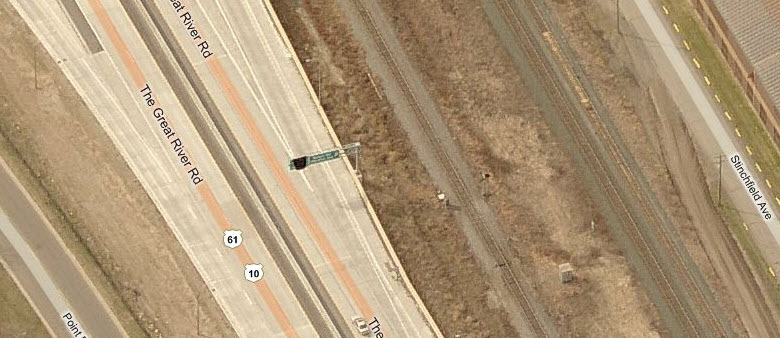
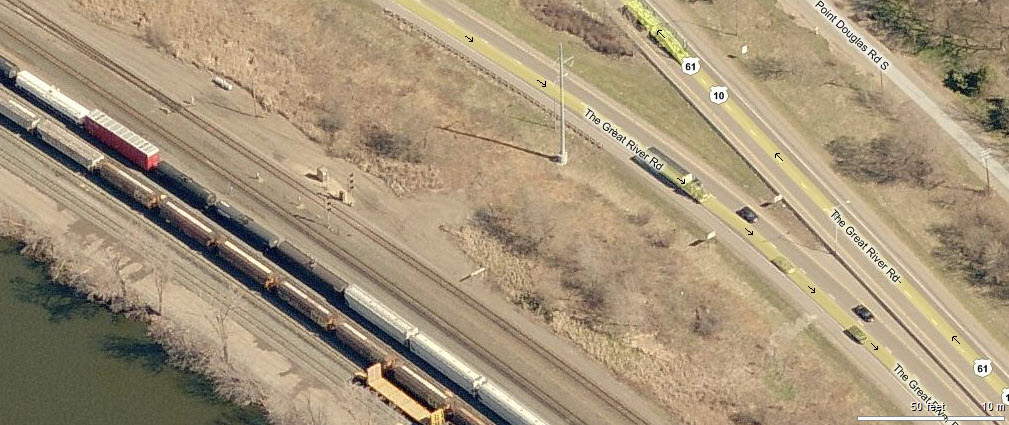
Toronto ON 1 - West side of
Union Station - CN and GO
This first set of pictures are of signals
mounted to a pedestrian overpass connected to one of the premier hotels in
Toronto, and offers the signalfan a close-up view of the signals.
These dwarf
signals are located trackside below the above set of pictures. Note the
unique triple signal searchlight dwarf housing!

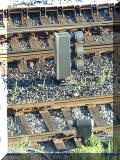
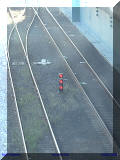



These pictures were taken on the west side
approach to Union Station. TUS is the busiest railroad station in Canada,
and services GO, VIA, Amtrak, and Ontario Northland. For more info,
click here.
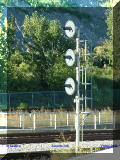
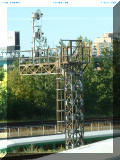
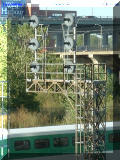
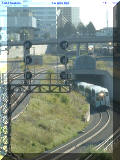
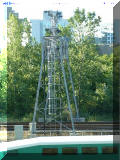

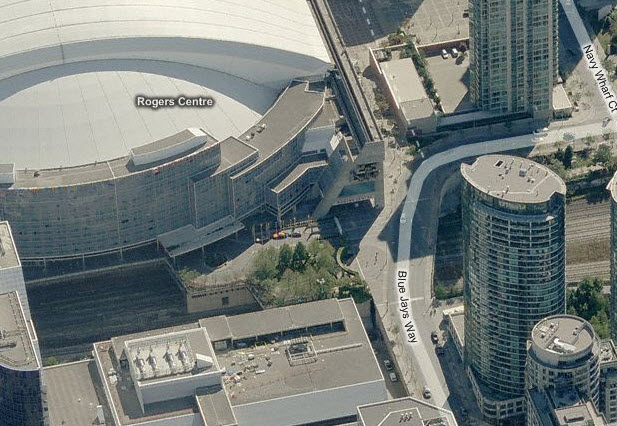
Just off of the center of the picture to the left is a traffic
circle where you drive up to register, and you will notice it is built over the
tracks, this is where the above pictures were taken from.... from
www.bing.com/maps

A Bing view of the tracks between said location and Toronto
Union Station.
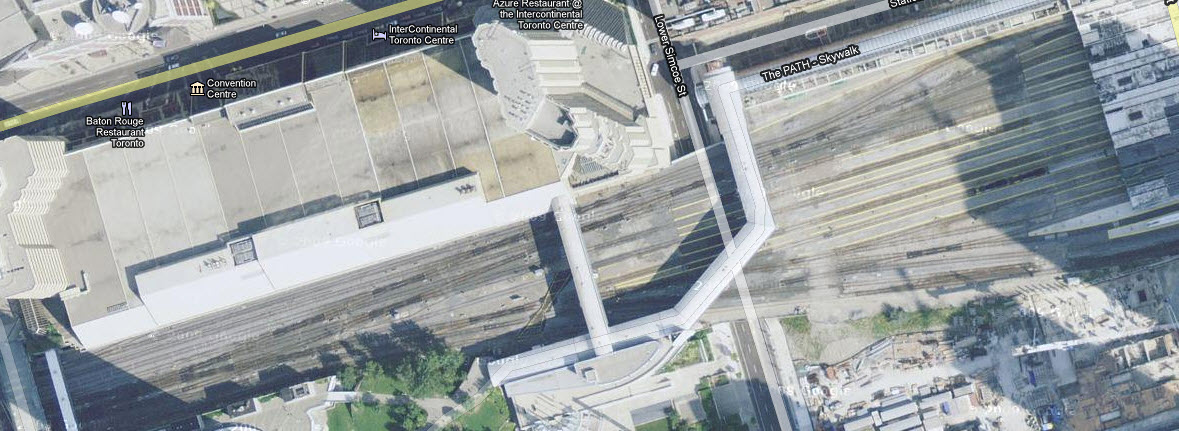
A satellite view of the same area, from
www.google.com maps, where it's a little
easier to see the double-slips and crossovers.
Disclaimers:
I love trains, and I love signals. I am not an expert.
If this is a railfan page, every effort has been made to make sure that the information contained on this map and in this railfan guide is correct. Once in a while, an error may creep in..... :-(
My philosophy: Pictures and maps are worth a
thousand words, especially for railfanning. Text descriptions only
get you so far, especially if you get lost or disoriented. Take
along good maps.... a GPS is OK to get somewhere, but maps are still
better if you get lost! I belong to AAA, which allows you to get
local maps for free when you visit the local branches. ADC puts
out a nice series of county maps for the Washington DC area, but their
state maps do not have the railroads on them. If you can find em,
I like the National Geographic map book of the U.S..... good, clear, and
concise graphics, and they do a really good job of showing you where
tourist type attractions are, although they too lack the railroads.
Other notes about specific areas will show up on that page if known.
Pictures and additional information is always needed if anyone feels
inclined to take 'em, send 'em, and share 'em, or if you have
something to add or correct.... credit is always given! BE NICE!!! Contact info
is here
Beware: If used as a source, ANYTHING from Wikipedia must be treated as being possibly being inaccurate, wrong, or not true.
RAILFAN GUIDES HOME
RAILROAD SIGNALS HOME
New: 10-6-2006
Last Mod: 19-Jan-2017